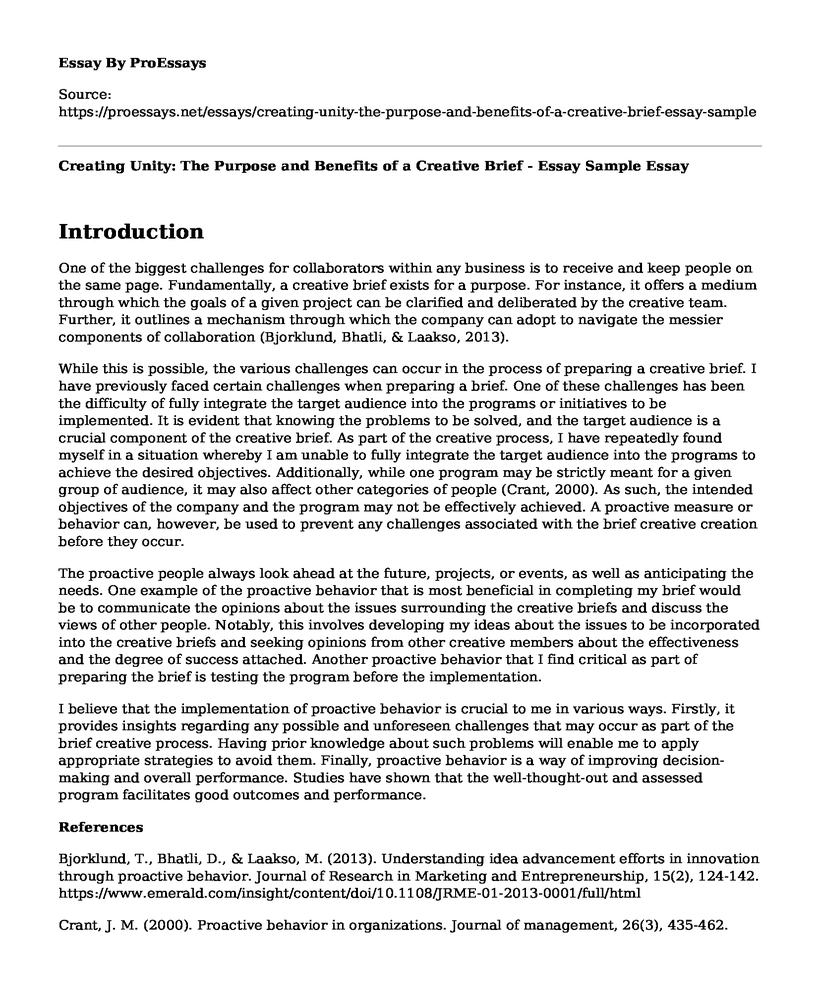Introduction
One of the biggest challenges for collaborators within any business is to receive and keep people on the same page. Fundamentally, a creative brief exists for a purpose. For instance, it offers a medium through which the goals of a given project can be clarified and deliberated by the creative team. Further, it outlines a mechanism through which the company can adopt to navigate the messier components of collaboration (Bjorklund, Bhatli, & Laakso, 2013).
While this is possible, the various challenges can occur in the process of preparing a creative brief. I have previously faced certain challenges when preparing a brief. One of these challenges has been the difficulty of fully integrate the target audience into the programs or initiatives to be implemented. It is evident that knowing the problems to be solved, and the target audience is a crucial component of the creative brief. As part of the creative process, I have repeatedly found myself in a situation whereby I am unable to fully integrate the target audience into the programs to achieve the desired objectives. Additionally, while one program may be strictly meant for a given group of audience, it may also affect other categories of people (Crant, 2000). As such, the intended objectives of the company and the program may not be effectively achieved. A proactive measure or behavior can, however, be used to prevent any challenges associated with the brief creative creation before they occur.
The proactive people always look ahead at the future, projects, or events, as well as anticipating the needs. One example of the proactive behavior that is most beneficial in completing my brief would be to communicate the opinions about the issues surrounding the creative briefs and discuss the views of other people. Notably, this involves developing my ideas about the issues to be incorporated into the creative briefs and seeking opinions from other creative members about the effectiveness and the degree of success attached. Another proactive behavior that I find critical as part of preparing the brief is testing the program before the implementation.
I believe that the implementation of proactive behavior is crucial to me in various ways. Firstly, it provides insights regarding any possible and unforeseen challenges that may occur as part of the brief creative process. Having prior knowledge about such problems will enable me to apply appropriate strategies to avoid them. Finally, proactive behavior is a way of improving decision-making and overall performance. Studies have shown that the well-thought-out and assessed program facilitates good outcomes and performance.
References
Bjorklund, T., Bhatli, D., & Laakso, M. (2013). Understanding idea advancement efforts in innovation through proactive behavior. Journal of Research in Marketing and Entrepreneurship, 15(2), 124-142. https://www.emerald.com/insight/content/doi/10.1108/JRME-01-2013-0001/full/html
Crant, J. M. (2000). Proactive behavior in organizations. Journal of management, 26(3), 435-462. http://homepages.se.edu/cvonbergen/files/2018/01/Proactive-Behavior-in-Organizations.pdf
Cite this page
Creating Unity: The Purpose and Benefits of a Creative Brief - Essay Sample. (2023, Mar 04). Retrieved from https://proessays.net/essays/creating-unity-the-purpose-and-benefits-of-a-creative-brief-essay-sample
If you are the original author of this essay and no longer wish to have it published on the ProEssays website, please click below to request its removal:
- BHF Restaurant Business Plan
- The Business Model, Creation, and Execution: Articles Analysis Essay
- Evaluation Essay on Restaurant
- Business Ethics in China Essay Example
- Essay Sample on Maintaining Professionalism: Meeting Objectives Through Ethical Standards
- Essay Example on Low-Skilled Grocery & Fast Food Jobs: Dead End with Low Pay
- Paper Example on Valeant CEOs' Unethical Practices: Price Gouging, Corporate Corruption & More







